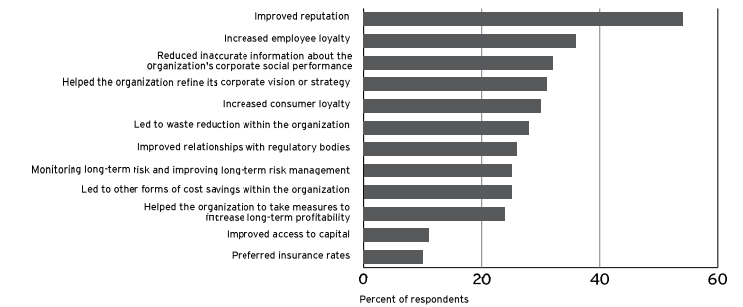
During the past few years, sustainability has become the new business buzzword. Many organizations are investing massively into something that can be called “sustainability transformations” and have started to think about sustainability as something strategic. In 2018, a whopping 86% on S&P 500 companies published sustainability reports and the share is still growing. Sustainability was also the central theme in Davos Summit 2020 where a bigger vision for stakeholder capitalism was grounded in the minds of the world leaders. Some companies have started with deliberate “nonmarket” strategies by understanding that actors beyond their own market are influencing the bottom line (ecosystems thinking).

Figure 1. Nonmarket environment by Bach and Allen 2010
For business leaders sustainability transformation is not only about an ethical choice, but also a business necessity to survive in the 2020s and beyond. This can be seen for example in the wide support from the corporate world for the #blacklivesmatter with publicity and investments for equality. They cannot afford not to.
Sustainability can be a win-win scenario because investing in sustainability is good for business and it is good for the planet as a whole. Sustainability is also tightly coupled with purpose, which organizations and individuals, especially millennials, are searching for and even struggling with now more than ever. What would be a greater purpose than saving our planet from the climate crisis and create more happiness in the world?
We are not on track
The cold fact is that we are not currently on track in reaching the sustainable development goals set out for 2030. Even though the COVID-19 crisis has brought many positive side-effects for the climate, in the big picture we are not currently achieving the 17 SDGs outlined by the UN in 2015. When the world’s countries are turning more inwards, we are looking for global corporate leaders and organizations to take some more leadership and responsibility in sustainability. The policies and regulations are not changing rapidly enough but fortunately, corporations could and should do it instead. Sustainability is not always mandatory from a regulatory perspective but is becoming it from a customer value perspective. An EY publication states that the main benefits from sustainability (reporting) include improved reputation, increased employee and customer loyalty, and refined strategy and vision.

Figure 2. Ways that sustainability reporting provided value by EY Publications
Strategies for sustainability
According to Professor Mike Rosenberg, there are six distinct strategic options for sustainability that companies can apply. In order to understand which strategy to apply, there needs to be an assessment of what kind of environmental sensibility exists in the ecosystem of the organization, e.g. among its customer, employees, investors, and other stakeholders. One of the strategies is a “break the law”, but in the year 2020 this is not a viable option for most organizations.

Figure 3. Strategic options for sustainability by Prof. Mike Rosenberg
- Take the low road strategy. In this strategy, the corporation only complies with the regulations of each of the countries laws and regulations. The company only reacts when the regulator demands it. From a legal perspective, this strategy is rock solid, but it might get costly for a late adopter in the long term since the regulations are bound to change.
- Wait and see. In this strategy, the management looks a bit beyond and adapts to the pressures that are coming from its customers and competitors for not to fall behind.
- Show and tell. In this option, the company chooses to do more, and tell the world about by actively using sustainability topics in its marketing. Professor Rosenberg notes that there is a fine line between the show and tell strategy and “greenwashing”, in where the company is portraying a picture about its brand that is not really true. Marketing cannot be anything else than the level of conviction and sincerity of the company. There is a big risk of exposure (e.g. Volkswagen scandal). The company needs to have a culture and a monitoring system to unlock this strategy.
- Pay for principle. In this strategy, the company decides to sacrifice some financial performance metrics in order to meet ethical and environmental standards. Here the rationale is not a medium-term business case, but instead, a deep belief in stopping climate change should be on the corporate agenda. In this scenario, the company is doing all possible measures to become more sustainable and e.g. carbon neutral. This could mean e.g. switching to all-vegan lunch options that are more expensive, green offices, or committing to pay the carbon offset or all corporate flights.
- Think ahead. In this strategy, the company understands that there is also a hard business logic that sustainability can build a competitive advantage. The company understands that it needs to be at the leading edge of the sustainability and immerses itself into a continuous sustainability transformation. This strategy means that the company needs to always be innovating around sustainability topics.
Conclusions
More than ever is sustainability on the table of boards and management teams. The people responsible for the corporate strategy need to have a deep understanding of sustainability issues but also an understanding of the future. For this, it is recommended to use methods like scenario analysis and futures thinking. Also, a main point is to include the whole organization into the sustainability transformation by co-creating a clear and compelling purpose and vision of the future. People need more education about these topics in order to understand where we are now. As organizations and individuals, we can make a difference. The sustainable development goals provide an outstanding framework as a starting point. It is time to prioritize solutions over the problems and understand that sustainability is a strategic choice.
References
Rosenberg, Mike: A Strategic Approach to Sustainability (2016). IESE Insight.
https://www.youtube.com/watch?v=3gZPv1KIJ0U#
https://hbr.org/2020/01/making-stakeholder-capitalism-a-reality
https://www.weforum.org/sustainability-world-economic-forum
https://sustainabledevelopment.un.org/?menu=1300



